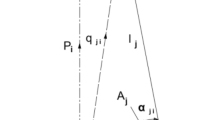Abstract
A description of the Workspace Prediction and Fast Matching System (WPFM System) is given. The purpose of the system is to exploit the special constraints on the identity and placement of objects in a typical industrial robot workcell to perform rapid analysis of stereo vision data derived from such a scene. The a-priori knowledge of the positions and identities of some objects can allow some stereo data to be quickly matched to model features, and subtracted out of the scene data, leaving unknown data to be dealt with by a more comprehensive (and more computationally expensive) vision matcher. A workspace prediction graph (WP Graph) for a given scene can be created using the Robmod CSG solid modelling system (the WP System). The 3D model features in the WP Graph can then be matched against 3D stereo data derived from the equivalent real scene, using the Fast a priori Matching System (FAPM System). Matching is currently carried out only with edge features. The stereo data used in the matching process is derived from the real scene by a low level stereo vision capability (the GDB System). Curved objects can be handled by the WPFM System, and these are represented in the WP Graph by polyhedral approximations, which are then matched to stereo data.
Similar content being viewed by others
References
AIVRU, GDB Release (1.0) User Documentation, AIVRU report 014, University of Sheffield (1986).
Aylett, J.C., A boundary representation for machine vision, Technical report, University of Edinburgh (in preparation).
Aylett, J.C., WPFM: The workspace prediction and fast matching system, Technical report WP207, University of Edinburgh (1987).
Baer, A. et al., Geometric Modelling: A Survey, Computer Aided Design 11, No. 5 (1979).
Blake, A. and Mayhew, J.E.W., Alvey 2-1/2D sketch project: proposed structure for a development system, AIVRU report, University of Sheffield (1985).
Bolles, R.C. and Cain, R.A., Recognising and locating partially visible objects: the local feature focus method, Robotics Research 1, No. 3 (1982).
Boyse, J.W., GMSolid: interactive modeling for design and analysis of solids, IEEE Computer Graphics and Automation, Mar. 1982, pp. 27–40 (1982).
Cameron, S.A., Modeling solids in motion, PhD thesis, University of Edinburgh (1984).
Cameron, S.A. and Aylett, J.C., robmod: A geometric engine for robotics, Proc. IEEE Conference for Robotics and Automation (1988).
Fisher, R.B., From surfaces to objects, PhD thesis. University of Edinburgh (1986).
Gray, M., Proposal for representing 3-D objects, IBM UK Scientific Centre (1985).
Grimson, W.E.L. and Lozano-Perez T., Model-based recognition and localisation from sparse range or tactile data, Int. J. Robotics Res. 3, No. 3 (Fall, 1984).
Pollard, S.B. et al., Matching geometrical descriptions in three space, AIVRU Working Paper No. 22, University of Sheffield (1986).
Popplestone, R.J., Ambler, A.P., and Bellos, I.M., An interpreter for a language describing assemblies, Artificial Intelligence 14, 79 (1980).
Pridmore, T.P., Bowen, J.B., and Mayhew, J.E.W., Geometrical description of the connect graph (version 2). The geometrical base description: a specification, AIVRU Report 012, University of Sheffield (1986).
Quarendon, P., WINSOM User's Guide (UKSC 123), IBM UK Scientific Centre (1984).
Requicha, A.A.G., Representation for rigid solids: theory, methods and systems, Computing Surveys 12, No. 4 (1980).
Requicha, A.A.G. and Voelcker, H.B., Solid modeling: A historical summary and contemporary assessment, Computing Surveys 12, No. 4 (1982).
Watson, R., An edge-based 3D geometrical model matching system, MSc dissertation, Department of Artificial Intelligence, University of Edinburgh (1985).
Weiler, K., Edge based data structures for solid modeling in curved surface environments, IEEE Computer Graphics and Automation, pp. 21–40 (Jan, 1985).
Wilson, P.R. et al., Interfaces for data transfer between solid modeling systems, IEEE Computer Graphics and Automation, pp. 41–51 (Jan, 1985).
Author information
Authors and Affiliations
Rights and permissions
About this article
Cite this article
Aylett, J.C., Fisher, R.B. & Fothergill, A.P. Predictive computer vision for robotic assembly. Journal of Intelligent and Robotic Systems 1, 185–201 (1988). https://doi.org/10.1007/BF00348722
Received:
Issue Date:
DOI: https://doi.org/10.1007/BF00348722




